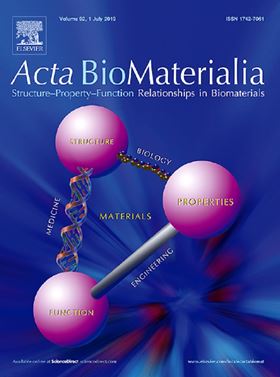
In the U.S. in 2015, 124 million adults reported suffering from a musculoskeletal-related health condition. These injuries have a significant impact on quality of life, as well as pose a significant economic burden, with an average of 10?days of work missed annually for those with musculoskeletal-related injuries (www.boneandjointburden.org). The environment surrounding and impacting musculoskeletal health continues to evolve as lifestyles and expectations change. Over the past 50+ years, a variety of metallic and polymeric biomaterials have been used successfully to restore function and reduce pain for many patients suffering from these injuries [1], [2]. However, significant challenges remain in the area of developing biomaterials for musculoskeletal applications. Prevention and treatment of implant associated infections, restoration of physical movement and load-bearing capacity, improved repair of large defects, and longer life expectancy after treatment are just a few examples [3], [4], [5].
In response, we have focused this special issue of Acta Biomaterialia on emerging efforts in biomaterials and their impact on improving human musculoskeletal health and wellbeing. We solicited contributions to this special issue from various tracks at the U.S. Society for Biomaterials 2018 Annual Meeting (held in Atlanta, GA), along with other open submissions.
Contributions to this special issue include review articles and original papers covering the development of biomaterials as antibiotic or drug delivery vehicles, as well as design of materials as cell carriers. Specific studies included in this special issue center around 3 main themes: 1) preventing infection, 2) building tissue using scaffolds and cells, and 3) localized biomolecule delivery to bone or cartilage.
The topic of antimicrobial and antibiotic efforts starts with a review article followed by several original articles on latest advances in coatings and release of active agents. The building tissue theme includes several articles on bone, followed by articles on cartilage/fibrocartilage regeneration. The last topic begins with two reviews focused on local drug delivery for musculoskeletal applications, followed by reviews and several original articles covering different approaches for drug delivery to bone. Subsequently, delivery to cartilage is explored through both reviews and original articles.
In summary, this special issue provides guidance for researchers through detailed review articles and timely information on the latest advances in several musculoskeletal applications for biomaterials. As such, we hope this special issue is a forum to both identify key challenges in the field, as well as highlight emerging research from the biomaterials community in treating musculoskeletal injuries.
To read the full special issue, please visit here (insert link): https://www.sciencedirect.com/journal/acta-biomaterialia/vol/93/suppl/C
References:
[1] B. Ratner, A. Hoffman, F. Schoen, J. Lemmons, Biomaterials Science: An Introduction to Materials in Medicine, third ed., 2012.
[2] J.S. Temenoff, A.G. Mikos, Biomaterials: The Intersection of Biology andMaterials Science, Pearson Prentice Hall, 2008.
[3] S. Behzadi, G.A. Luther, M.B. Harris, O.C. Farokhzad, M. Mahmoudi,Nanomedicine for safe healing of bone trauma: opportunities and challenges,Biomaterials 146 (2017) 168–182.
[4] K. Prasad, O. Bazaka, M. Chua, M. Rochford, L. Fedrick, J. Spoor, R. Symes, M.Tieppo, C. Collins, A. Cao, D. Markwell, K.K. Ostrikov, K. Bazaka, Metallicbiomaterials: current challenges and opportunities, Materials (Basel) 10 (8)(2017). pii: E884.
[5] M.P. Siljander, A.H. Sobh, K.C. Baker, E.A. Baker, L.M. Kaplan, Multidrug-resistantorganisms in the setting of periprosthetic joint infection-diagnosis, prevention,and treatment, J. Arthroplasty 33 (1) (2018) 185–194